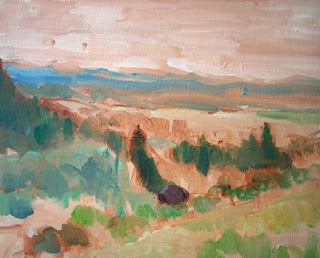
Introduction to plein air painting: basic concepts and materials
The goal of the plein air painter is to create an original and accurate rendering of the scene (called the motif) one is facing with sufficient interplay of dark and light areas as to be aesthetically interesting and dynamic, revealing a limited number of basic forms and an appropriate atmosphere as to be a convincing landscape while at the same time a poetic statement.
Tentative class schedule:
- s1: orientation and materials and some painting (Maude Kerns)
- s2: design, composition, sketching, and "macchia" concept (Brackenfern St.)
- s3: colors and color mixing (LCC Parking Lot)
- s4: gesture and perspective in landscape painting (location TBA)
- s5: creating atmospheric perspective (location TBA)
- s6: simplifying forms and establishing eye movement (location TBA)
Any appropriate paints and supports can be used but instruction will mostly be concerned with oil painting. A small pochade box is recommended with a limited palette of colors. Below is a photo of my french easel, I will post a photo of my pochade box later.

- cadmium red light and medium
- cadmium yellow medium and yellow ochre
- ultramarine blue, cerulean blue, thalo blue
- viridian or thalo green
- alizarin crimson
- titanium white
- burnt sienna
We shall begin by discussing drawing, typically with the brush using a burnt sienna thinned with the medium (50% mineral spirits and 50% linseed oil). Walnut oil can be substituted but drying time wil be greatly extended. Students are encouraged to draw with charcoal, red chalk, and pencil whenever possible and to maintain a sketchbook of landscape notes at all times.


Demo: Beginning with a burnt sienna sketch:



Key concept numero uno:
Although the beginner is rightly concerned with just learning sufficient techniques to cover a canvas with paint and create a reasonable painting, too much focus on technique alone results in the "schlock" phenomenon: all plein air paintings resemble one another and seem to be painted by the same artist. Most "how to" books and web sites seem to be going in this direction.
The fallacy of this approach is evident whenever you visit the impressionist section of any good art museum. All the best impressionists broke every rule in the book and their paintings are wonderfully individualistic. Too much of an obsession with rules and techniques will ruin you. Think of them as guidelines only. Seek your "own voice" and identity. Put on your "schlock-o-meter", so that you can detect schlock when it begins to appear in your own work. Walk into any fancy art gallery and see what they are selling. All those "sheep paintings" and idyllic, highly detailed works are 90% schlock. Now go and look at a real Van Gogh. My case rests.

"Near Mount Pisgah"

"Glenwood"
What to look at?
I recommend looking at Constable, the early Mondrian, Corot, any of the I Macchiaioli but especially Signorini, Fattori, Abatti, etc., any of the French impressionists and post-impressionists, Americans like John Singer Sargent and Childe Hassam.
Assigment One: On location at Snowberry Street (off of Brackenfern), paint the vista of Springfield:

Note: Begin your study in monochrome using burnt sienna. Paint a study in values at first disregarding color. Try to keep the overall sketch light (avoid an overall dark sienna sketch...however, this may prove difficult as the evening becomes dark) and only gradually add color:
Remember to paint in architectural elements rather than deliberately painting them out. Look for "base lines", that is, horizontal or diagonal line sthat sweep across the entire vista. This helps give the painting structure and coherence.
Basic Concept: "Macchia" -- to the I Macchiaioli it mant "spot" or "dab" but also "underbrush" or "outlaw". The metaphorical meaning was clear, given the historic context, that macchia meant "seed" or "germinal cell", the underlying sketch that spontaneously and quickly grasped the essence of a scene in as few brushstrokes as possible. The idea was that if you got this macchia wrong, no further elaboration with color or further drawing would help.
A related concept is "alla prima" or direct (immediate) attack wherein each brushstroke is left where it hits the canvas without any attempt to blend it in.
We will discuss these ideas further in subsequent classes but the notion of "outlaw" and "hiding out in the underbush" (of, say, Maremma, Tuscany) was also a metaphor for sneaking up on nature and catching her "by surprise." This, to emphasize the spantaneous and rapid manner of painting to catch the fleeting changes in nature, the subtle light effects that are very subtle yet essential to the scene.
1 comment:
lovely
Post a Comment